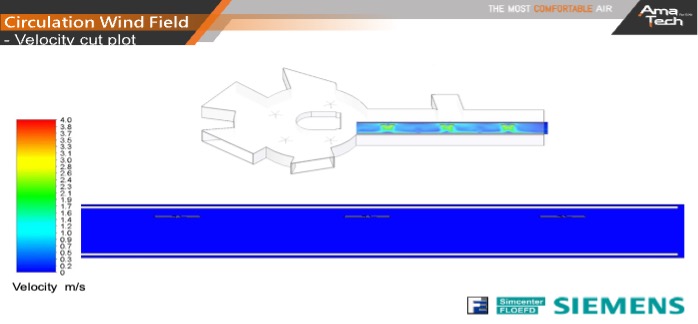Introduction: High Volume Low Speed (HVLS) fans are widely used in industrial and commercial spaces to improve air circulation, enhance comfort, and increase energy efficiency. Understanding the airflow patterns and performance characteristics of HVLS fans is crucial for optimizing the project design and maximizing the effectiveness. Computational Fluid Dynamics (CFD) provides a powerful toolset for simulating and analysing airflow in and around HVLS fans. This report explores the application of CFD in analysing HVLS fan performance and optimizing the project design for various applications.
Methodology:
- Geometry Setup: The geometry of the HVLS fan, including blades, hub, and surrounding structures, is modelled in a CAD software environment. Special attention is given to accurately representing the unique geometry and dimensions of HVLS fan blades.
- Mesh Generation: A high-quality mesh is generated around the HVLS fan geometry, ensuring sufficient resolution to capture flow features near the blades and in the surrounding space. Structured or unstructured meshing techniques may be employed based on the complexity of the geometry and flow physics.
- Boundary Conditions: Boundary conditions are defined based on the operating conditions of the HVLS fan system, including inlet velocity, outlet pressure, and wall conditions. Turbulence models such as k-ε or SST are selected to capture the effects of turbulence on flow behaviour accurately.
- Solver Settings: The appropriate solver settings are chosen to ensure convergence and accuracy of the CFD simulation. Iterative solvers, turbulence models, and numerical schemes are adjusted as needed to achieve reliable results within reasonable computational resources.
- Simulation Runs: The CFD simulation is executed, and key performance metrics such as airflow velocity distribution, air circulation patterns, and aerodynamic forces on the blades are analysed. Multiple operating conditions and fan configurations may be simulated to assess performance under different scenarios.
- Post-Processing: Post-processing techniques such as contour plots, streamlines, and vector plots are used to visualize airflow patterns and identify areas of recirculation, stagnation, or turbulence. Performance metrics such as air velocity distribution, flow rate, and power consumption are extracted and compared against project specifications or experimental data.
Case study:
This is a project is for a bus interchange. We use the CFD simulation to show the customer the airflow patterns generated by the HVLS fan as well as the key performance metrics such as air velocity distribution and airflow rate.
Before going for the CFD simulation, we must make sure all the boundaries are clearly identified.
We must also indicate the exact location of the fan installation and finally to determine the pole of the fan to set the height of the fan from the floor.
All these factors will directly determine the performance of the fan and hence affect the outcome of the CFD result.
Below is the CFD simulation done for the bus interchange project.

Results and Analysis:
- Flow Visualization: CFD simulations provide detailed insights into airflow patterns generated by the HVLS fan, including the formation of large-scale vortices, boundary layer effects, and interactions with surrounding structures.
- Performance Metrics: Key performance metrics such as air velocity distribution, airflow rate, and aerodynamic efficiency are calculated from the simulation results. These metrics are compared against project targets or experimental data to assess the accuracy of the simulation and identify areas for improvement.
- Sensitivity Analysis: Parametric studies are conducted to investigate the sensitivity of HVLS fan performance to various project design parameters such as fan size, rotational speed, and fan location. This analysis helps identify critical factors influencing fan performance and guide optimization efforts.
Conclusion: Computational Fluid Dynamics (CFD) offers a robust methodology for analysing and optimizing the performance of High Volume Low Speed (HVLS) fans in various applications. By simulating airflow patterns, pressure distributions, and aerodynamic forces, CFD enables engineers to gain valuable insights into HVLS fan behaviour and optimize the project design for improved performance and energy efficiency. By leveraging CFD simulations, designers and engineers can enhance the effectiveness of HVLS fans in providing comfortable and well-ventilated spaces while minimizing energy consumption and operating costs.
Should you have any enquiry, please feel free to contact the below.
- Francis Er (For SEA enquiry)
+65 9115 4361
- Senthil Kumar (For India enquiry)
+91 85080 24918
.png)

.png)